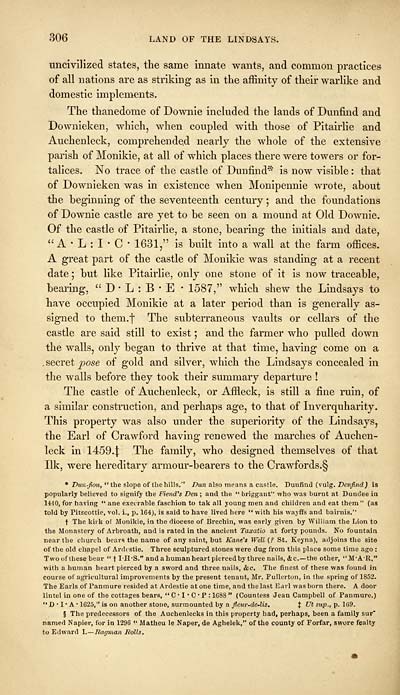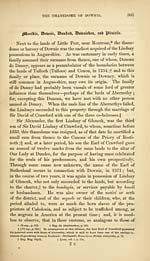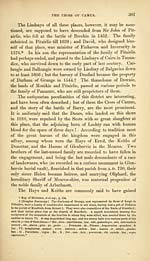Download files
Complete book:
Individual page:
Thumbnail gallery: Grid view | List view

306 LAND OF THE LINDSAYS.
uncivilized states, the same innate wants, and common practices
of all nations are as striking as in the affinity of their warlike and
domestic implements.
The thanedome of Downie included the lands of Dunfind and
Downieken, which, when coupled with those of Pitairlie and
Auchenleck, comprehended nearly the whole of the extensive
parish of Monikie, at all of which places there were towers or for-
talices. No trace of the castle of Dunfind* is now visible : that
of Dowuieken was in existence when Monipennie wrote, about
the beginning of the seventeenth century ; and the foundations
of Downie castle are yet to be seen on a mound at Old Downie.
Of the castle of Pitairlie, a stone, bearing the initials and date,
" A • L : I • C • 1631," is built into a wall at the farm offices.
A great part of the castle of Monikie was standing at a recent
date ; but like Pitairlie, only one stone of it is now traceable,
bearing, " D • L : B ■ E • 1587," which shew the Lindsays to
have occupied Monikie at a later period than is generally as-
signed to them.f The subterraneous vaults or cellars of the
castle are said still to exist ; and the farmer who pulled down
the walls, only began to thrive at that time, having come on a
. secret pose of gold and silver, which the Lindsays concealed in
the walls before they took their summary departure !
The castle of Auchenleck, or Affleck, is still a fine ruin, of
a similar construction, and perhaps age, to that of Inverquharity.
This property was also under the superiority of the Lindsays,
the Earl of Crawford having renewed the marches of Auchen-
leck in 14594 The family, who designed themselves of that
Ilk, were hereditary armour-bearers to the Crawfords.§
• DuK-fion, "the slope of tlie hills." Dun also means a castle. Duufind (vulg. Denfind) is
popularly believed to signify the Fiend's Den ; and the " briggant" who was burnt at Dundee in
14-10, for having *' ane execrable faschion to tak all young men and children and eat them" (as
told by Pitscottie, vol. i., p. 164), is said to have lived here " with his wayffs and bairnis."
t The kirk of Monikie, in the diocese of Brechin, was early given by William the Lion to
the Monastery of Arbroath, and is rated in the ancient Taxatlo at forty pounds. No fountain
near the church bears the name of any saint, but Kane's Well (? St. Keyna), adjoins the site
of the old chapel of Ardistie. Three sculptured stones were dug from this place some time ago :
Two of these bear " t IH'S." and a human heart pierced by three nails, &c— the other, "M-A-R,"
with a human heart pierced by a sword and three nails, &c. The finest of these was found in
course of agricultural improvements by the present tenant, Mr. Fullerton, in the spring of 1852.
The Earls of Panmure resided at Ardestie atone time, and the last Earl was born there. A door
lintel in one of the cottages bears, " C • I • C • P : 1088 " (Countess Jean Campbell of Panmure.)
" D • I • A • 1625," is on another stone, surmounted by a fleur-de-lis. X Ut sup., p. 169.
§ The predecessors of the Auchenlecks in this property had, perhaps, been a family sur"
named Napier, for in 1296 " Matheu le Naper, de Aghelek," of the county of Forfar, swore fealty
to Edward I.— Ragman Rolls.
uncivilized states, the same innate wants, and common practices
of all nations are as striking as in the affinity of their warlike and
domestic implements.
The thanedome of Downie included the lands of Dunfind and
Downieken, which, when coupled with those of Pitairlie and
Auchenleck, comprehended nearly the whole of the extensive
parish of Monikie, at all of which places there were towers or for-
talices. No trace of the castle of Dunfind* is now visible : that
of Dowuieken was in existence when Monipennie wrote, about
the beginning of the seventeenth century ; and the foundations
of Downie castle are yet to be seen on a mound at Old Downie.
Of the castle of Pitairlie, a stone, bearing the initials and date,
" A • L : I • C • 1631," is built into a wall at the farm offices.
A great part of the castle of Monikie was standing at a recent
date ; but like Pitairlie, only one stone of it is now traceable,
bearing, " D • L : B ■ E • 1587," which shew the Lindsays to
have occupied Monikie at a later period than is generally as-
signed to them.f The subterraneous vaults or cellars of the
castle are said still to exist ; and the farmer who pulled down
the walls, only began to thrive at that time, having come on a
. secret pose of gold and silver, which the Lindsays concealed in
the walls before they took their summary departure !
The castle of Auchenleck, or Affleck, is still a fine ruin, of
a similar construction, and perhaps age, to that of Inverquharity.
This property was also under the superiority of the Lindsays,
the Earl of Crawford having renewed the marches of Auchen-
leck in 14594 The family, who designed themselves of that
Ilk, were hereditary armour-bearers to the Crawfords.§
• DuK-fion, "the slope of tlie hills." Dun also means a castle. Duufind (vulg. Denfind) is
popularly believed to signify the Fiend's Den ; and the " briggant" who was burnt at Dundee in
14-10, for having *' ane execrable faschion to tak all young men and children and eat them" (as
told by Pitscottie, vol. i., p. 164), is said to have lived here " with his wayffs and bairnis."
t The kirk of Monikie, in the diocese of Brechin, was early given by William the Lion to
the Monastery of Arbroath, and is rated in the ancient Taxatlo at forty pounds. No fountain
near the church bears the name of any saint, but Kane's Well (? St. Keyna), adjoins the site
of the old chapel of Ardistie. Three sculptured stones were dug from this place some time ago :
Two of these bear " t IH'S." and a human heart pierced by three nails, &c— the other, "M-A-R,"
with a human heart pierced by a sword and three nails, &c. The finest of these was found in
course of agricultural improvements by the present tenant, Mr. Fullerton, in the spring of 1852.
The Earls of Panmure resided at Ardestie atone time, and the last Earl was born there. A door
lintel in one of the cottages bears, " C • I • C • P : 1088 " (Countess Jean Campbell of Panmure.)
" D • I • A • 1625," is on another stone, surmounted by a fleur-de-lis. X Ut sup., p. 169.
§ The predecessors of the Auchenlecks in this property had, perhaps, been a family sur"
named Napier, for in 1296 " Matheu le Naper, de Aghelek," of the county of Forfar, swore fealty
to Edward I.— Ragman Rolls.
Set display mode to:
![]() Universal Viewer |
Universal Viewer | ![]() Mirador |
Large image | Transcription
Mirador |
Large image | Transcription
Images and transcriptions on this page, including medium image downloads, may be used under the Creative Commons Attribution 4.0 International Licence unless otherwise stated. ![]()
| Histories of Scottish families > History and traditions of the land of the Lindsays in Angus and Mearns > (324) Page 306 |
|---|
| Permanent URL | https://digital.nls.uk/94872914 |
|---|
| Description | A selection of almost 400 printed items relating to the history of Scottish families, mostly dating from the 19th and early 20th centuries. Includes memoirs, genealogies and clan histories, with a few produced by emigrant families. The earliest family history goes back to AD 916. |
|---|

